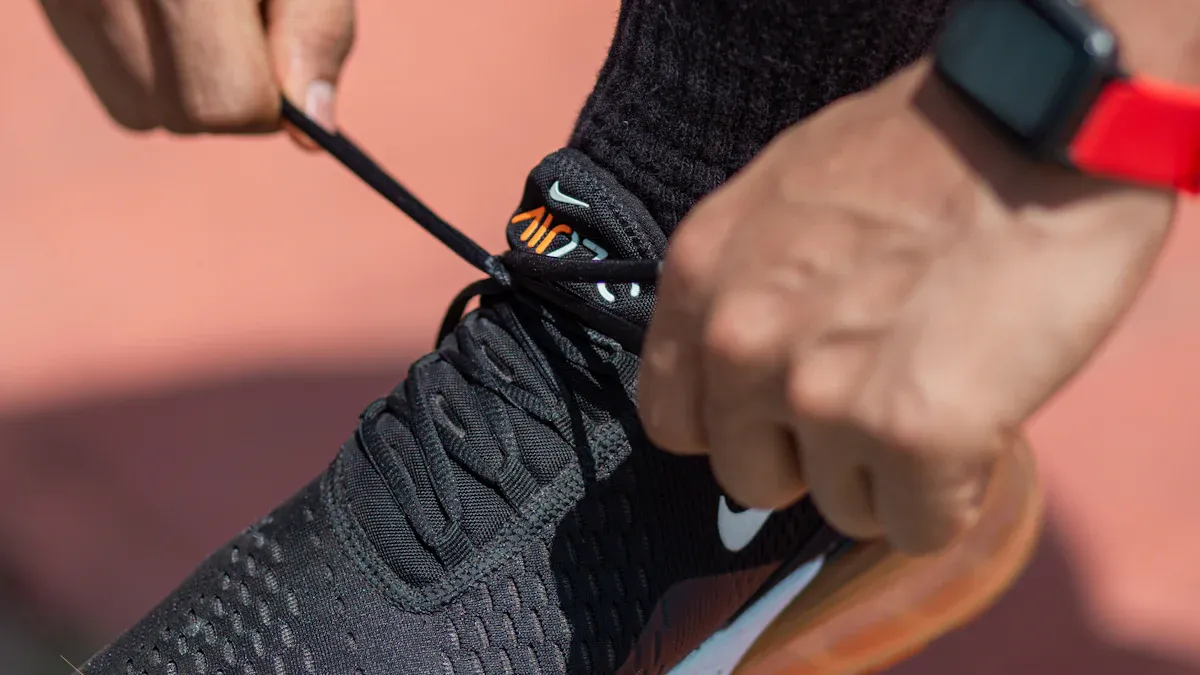
Have you ever thought about how something as simple as socks can impact your fitness and the planet? Breathable socks aren’t just about keeping your feet dry—they’re a game-changer for both performance and sustainability.
For instance, performance grip socks, designed for stability and traction, are growing in popularity. The market for these socks is expected to reach $1.7 billion by 2028, showing how important they’ve become for athletes like you. Plus, brands are now using sustainability performance materials like organic cotton or recycled fibers to create eco-friendly options. This shift is helping reduce waste and promote greener fitness routines.
By choosing breathable socks made with care for the environment, you’re not only boosting your workout but also supporting a healthier planet. It’s a small change that makes a big difference.
Key Takeaways
- Breathable socks help workouts by improving grip and stopping slips. They also activate muscles for better balance and control.
- Picking eco-friendly socks made from bamboo or organic cotton helps the planet and lowers waste.
- Socks with moisture-wicking keep feet dry, stop blisters, and prevent bad smells, making workouts more comfortable.
- Buying strong socks means less waste and saves money since they last longer and need fewer replacements.
- Choosing brands with eco-certifications helps support the environment and keeps Earth healthier.
What Is the Science Behind Breathable Socks?
How Breathable Socks Improve Fitness Performance
Breathable socks do more than keep your feet dry—they actively enhance your workout. They reduce slipping, distribute pressure evenly, and engage stabilizing muscles. These features improve your balance and help you move with more control. For example, socks with a higher coefficient of friction (COF) provide better grip, which is perfect for activities like running or yoga.
Here’s a quick breakdown of how breathable socks boost your performance:
| Metric | Description |
|---|---|
| Coefficient of Friction | Less slipping, more stability and control. |
| Pressure Distribution | Reduces impact forces and minimizes strain. |
| Muscle Engagement | Activates stabilizing muscles for better balance and movement. |
When your socks work this hard, you can focus on pushing your limits without worrying about discomfort or injuries.
Sustainability Performance Materials in Sock Design
Choosing socks made with sustainability performance materials is a win for both your fitness and the planet. Brands are now using eco-friendly options like Merino wool, bamboo, and recycled fibers to create socks that last longer and reduce waste. Merino wool, for instance, is a renewable resource that decomposes in just 6-12 months, unlike synthetic fibers that can take decades.
Here are some standout practices from eco-conscious brands:
| Brand | Material/Practice Description | Environmental Benefit |
|---|---|---|
| Jogology | Uses 80% post-consumer waste board in packaging and avoids plastic in shipping. | Reduces plastic waste in packaging. |
| Balega | Achieved Climate Neutral Certification by measuring climate impact and offsetting carbon emissions. | Reduces overall carbon footprint. |
| Mizuno | Over 90% recycled content in upper body textile and plant-based Wave plate in Wave Rider 27. | Utilizes recycled materials, reducing waste. |
| Saucony | Triumph RFG features recycled materials and a 55% corn-based foam midsole, minimizing plastic use. | Decreases reliance on plastic materials. |
By choosing socks made with these materials, you’re supporting brands that prioritize sustainability while enjoying high-quality performance gear.
The Role of Moisture-Wicking in Comfort and Sustainability
Moisture-wicking technology is a game-changer for keeping your feet dry and comfortable during workouts. Materials like Merino wool and Gore-Tex excel at pulling moisture away from your skin, preventing blisters and odor. Plus, these materials are sustainable. Merino wool is natural and renewable, while Gore-Tex is durable and long-lasting, reducing the need for frequent replacements.
Here’s how different materials stack up:
| Material Type | Moisture Management | Comfort Level | Sustainability Practices |
|---|---|---|---|
| Merino Wool | High | Excellent | Natural, renewable |
| Polyester | High | Good | Often recycled |
| Gore-Tex | High | Excellent | Durable, long-lasting |
| Cotton | Low | Poor | Non-sustainable |
When you choose socks with moisture-wicking properties, you’re not just investing in comfort—you’re also making a sustainable choice that benefits the planet.
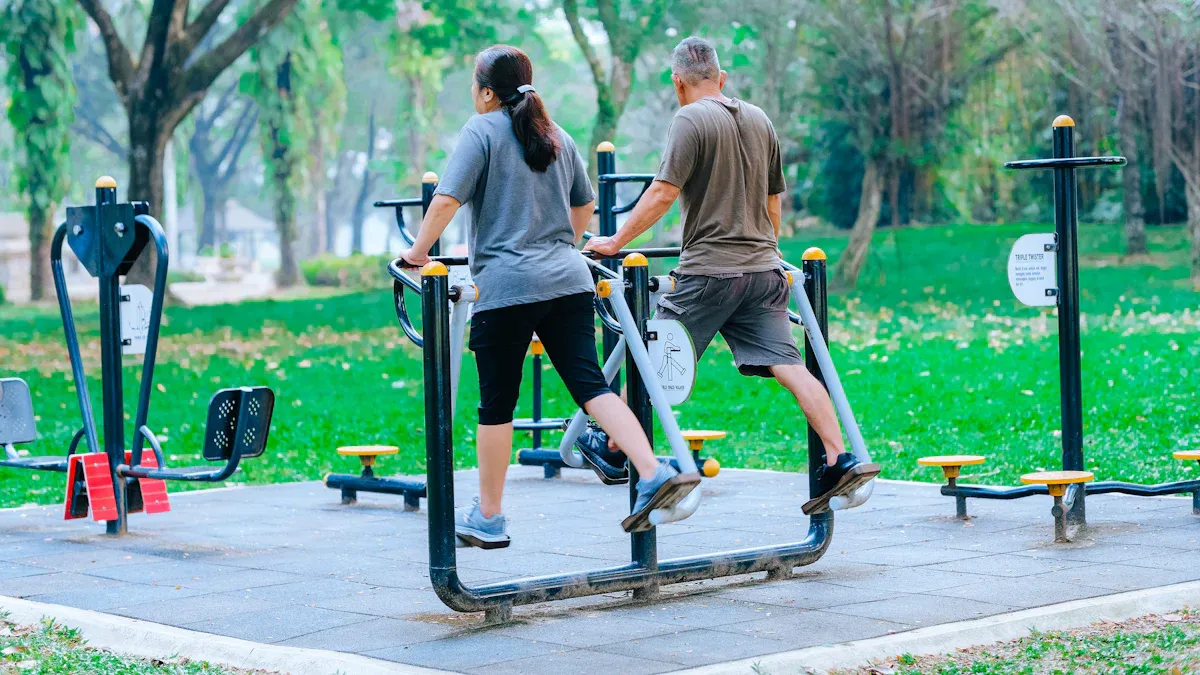
How Do Breathable Socks Benefit Both Fitness and the Environment?
Physical Benefits: Comfort, Hygiene, and Foot Health
Breathable socks aren’t just about keeping your feet dry—they’re a foundation for better foot health. When your feet stay cool and dry, you avoid common issues like blisters, odor, and fungal infections. Socks made from materials like bamboo and Merino wool excel at moisture-wicking, which keeps sweat away from your skin. This reduces bacterial growth and keeps your feet fresh during workouts.
Different materials offer unique benefits for comfort and hygiene:
| Material | Thickness | Benefits |
|---|---|---|
| Cotton | Lightweight | Breathable and moisture-wicking, ideal for warm weather. |
| Wool | Lightweight | Reduces odor and wicks moisture, perfect for active lifestyles. |
| Bamboo | Lightweight | Silky soft, temperature-regulating, and great for sensitive skin. |
| Microfiber | Lightweight | Quick-drying and cushioned for added comfort. |
Breathable socks also act as a protective layer, reducing friction between your feet and shoes. This prevents calluses and cracked heels, leaving your skin smoother and healthier. To maximize hygiene, keep your socks clean and consider moisturizing your feet to prevent dryness.
Tip: Choose socks with antimicrobial properties for an extra layer of protection against odor and bacteria.
Environmental Benefits: Reducing Waste with Sustainable Materials
Switching to socks made from sustainability performance materials is one of the easiest ways to reduce your environmental footprint. Eco-friendly options like organic cotton, recycled fibers, and bamboo are less harmful to the planet. These materials require fewer resources to produce and decompose faster than synthetic alternatives.
Here’s why sustainable socks matter:
- Eco-friendly materials minimize environmental harm.
- Companies using sustainable practices conserve resources and reduce waste.
- Supporting brands that prioritize sustainability contributes to a healthier planet.
Globally, 92 million tonnes of textile waste are produced each year. Nearly all clothing, including socks, can be recycled to reduce this staggering number. By choosing socks made from recycled fibers or organic materials, you’re helping to combat waste and promote a circular economy.
Note: Look for brands that use innovative recycling technologies and circular economy principles to further reduce their environmental impact.
Performance Benefits: Enhanced Endurance and Reduced Fatigue
Breathable socks don’t just keep your feet comfortable—they actively improve your performance. Socks with compression features enhance blood circulation, which reduces swelling and aids muscle recovery. This means you can train harder and recover faster.
Here’s how breathable socks boost endurance and reduce fatigue:
- They keep your feet dry and prevent overheating, which helps you stay focused during workouts.
- Compression socks improve blood flow, reducing soreness and speeding up recovery.
- Moisture-wicking properties prevent blisters, allowing you to train longer without discomfort.
When your feet feel good, your entire workout improves. Breathable socks help you avoid distractions like sweaty feet or painful blisters, so you can focus on achieving your fitness goals.
Pro Tip: For high-intensity activities, choose socks with reinforced arch support and cushioning to reduce strain and improve stability.
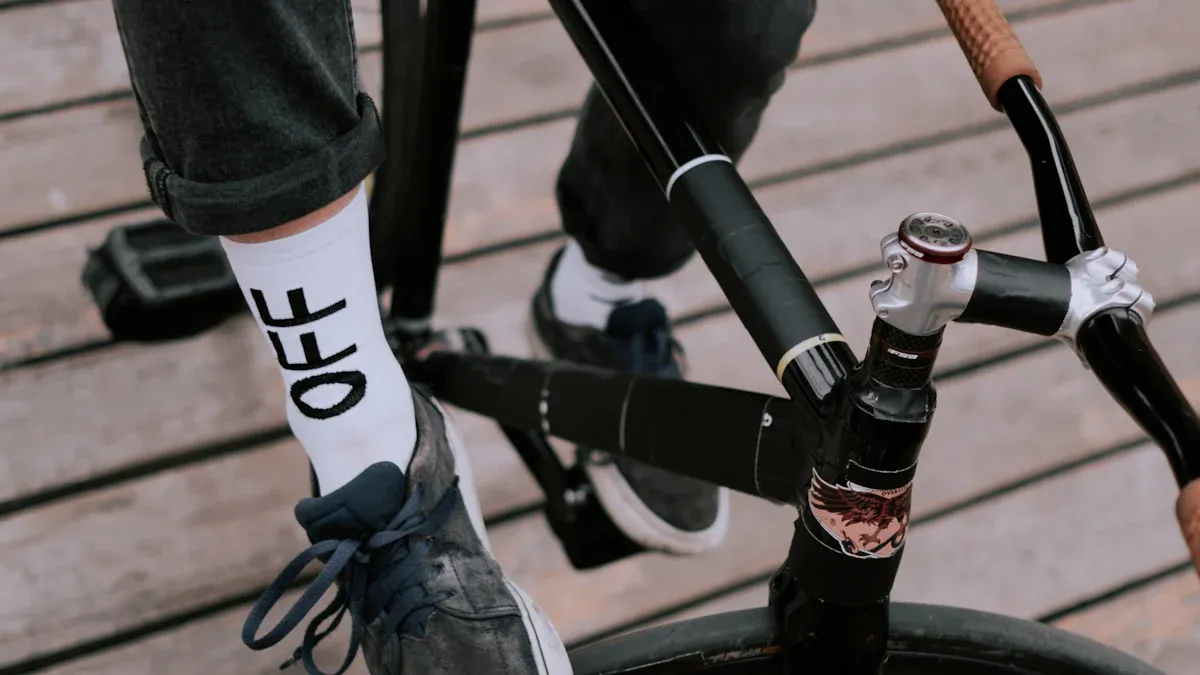
How to Choose the Best Eco-Friendly Breathable Socks
Finding the perfect eco-friendly breathable socks doesn’t have to be overwhelming. By focusing on the right materials, certifications, and durability, you can make a choice that benefits both your feet and the planet. Let’s break it down step by step.
Identifying Sustainability Performance Materials (e.g., Bamboo, Organic Cotton, Recycled Fibers)
The materials used in your socks play a huge role in their comfort, performance, and environmental impact. Look for sustainability performance materials like bamboo, organic cotton, and recycled fibers. These options not only feel great but also help reduce your carbon footprint.
- Bamboo: This fast-growing plant absorbs a lot of carbon dioxide and requires minimal chemicals to thrive. It’s soft, moisture-wicking, and biodegradable, making it a top choice for eco-conscious consumers.
- Organic Cotton: Unlike conventional cotton, organic cotton is grown without harmful chemicals. While it uses less pesticide, it does require significant water, so it’s important to choose brands that prioritize water-efficient farming.
- Recycled Fibers: Materials like recycled polyester or nylon give new life to old textiles and plastic waste. They reduce the need for virgin resources and help combat the growing problem of textile waste.
Here’s a quick comparison of popular materials to help you decide:
| Material Type | Pros | Cons | Production Cost (USD) |
|---|---|---|---|
| Bamboo Fiber | Soft, moisture-wicking, eco-friendly | Requires careful washing | $1.50 – $3.00 per pair |
| Organic Cotton | Chemical-free, breathable | High water usage | $1.00 – $2.00 per pair |
| Recycled Fibers | Reduces waste, durable | Limited availability | $1.50 – $3.00 per pair |
| Merino Wool | Warm, moisture-wicking, biodegradable | Higher price, special care needed | $2.00 – $4.00 per pair |
Tip: If you’re looking for socks that balance comfort and sustainability, bamboo and organic cotton are excellent choices for everyday wear.
Checking for Eco-Certifications (e.g., GOTS, OEKO-TEX, Fair Trade)
Eco-certifications are your best friend when it comes to verifying the sustainability of your socks. These labels ensure that the materials and production processes meet strict environmental and ethical standards. Here are some certifications to look for:
- GOTS (Global Organic Textile Standard): This certification guarantees that the socks are made from organic fibers and processed without harmful chemicals. It also ensures proper wastewater treatment and prohibits environmentally hazardous substances.
- OEKO-TEX: Products with this label are tested for harmful substances, ensuring they’re safe for both you and the environment.
- Fair Trade: This certification focuses on ethical practices, ensuring fair wages and safe working conditions for workers involved in production.
Each certification has its own focus, but they all share a commitment to sustainability and transparency. For example, GOTS-certified products undergo on-site inspections to verify compliance with environmental and social standards. This means you can trust that your socks are truly eco-friendly.
Note: Always check the label or product description for these certifications. They’re a reliable way to ensure you’re making a responsible choice.
Prioritizing Durability and Longevity for Reduced Environmental Impact
Durability matters more than you might think. Socks that last longer reduce the need for frequent replacements, which means less waste and fewer resources used in production. When choosing socks, look for materials and designs that prioritize longevity.
- Alpaca Wool: Known for its strength, alpaca wool makes socks that are less prone to tearing or wearing out. Plus, it’s biodegradable, so it won’t sit in a landfill for years.
- Reinforced Designs: Socks with reinforced heels and toes are built to withstand heavy use, making them a great option for active lifestyles.
- High-Quality Blends: Materials like bamboo and Merino wool, when combined with durable fibers like Lycra, create socks that are both comfortable and long-lasting.
By investing in durable socks, you’re not just saving money—you’re also helping the planet. Fewer replacements mean less waste and a smaller environmental footprint.
Pro Tip: To extend the life of your socks, wash them in cold water and avoid using harsh detergents. Proper care goes a long way in maintaining their quality.
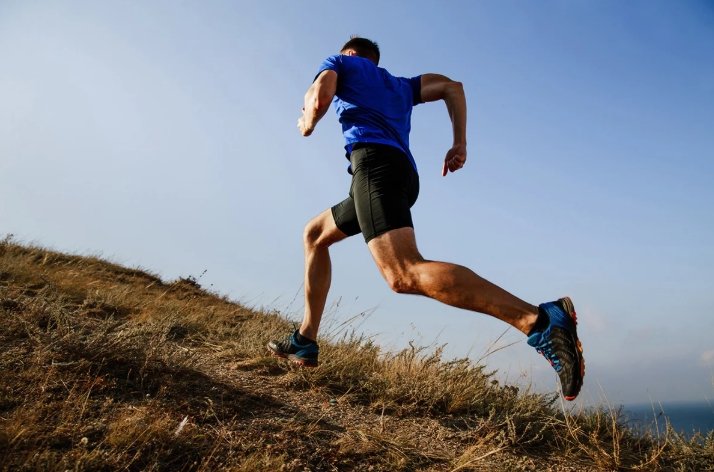
How Can You Incorporate Breathable Socks Into Your Fitness Routine?
Matching Socks to Different Workouts (e.g., Running, Yoga, Hiking)
Choosing the right socks for your workout can make a big difference in your performance and comfort. Different activities demand specific features, and breathable socks are designed to meet those needs. For example, running socks often use moisture-wicking materials like Merino wool or synthetic fibers to keep your feet dry and blister-free. Yoga socks, on the other hand, focus on grip and flexibility, ensuring stability during poses. Hiking socks prioritize cushioning and durability to protect your feet on rugged trails.
Here’s a quick comparison of how fabric design impacts performance:
| Study | Focus | Findings |
|---|---|---|
| Havlová, M. (2013) | Air permeability and constructional parameters | Shows how fabric design impacts air flow. |
| Umair, M. et al. (2016) | Structure of woven fabric | Explains how fabric design helps with air and moisture control. |
| Zhu, G. et al. (2018) | Structural parameters of cotton woven fabric | Predicts air flow based on fabric design. |
| Marie, H. (2018) | Air and water vapor permeability | Studies how fabric design affects air and water flow. |
Tip: For sweaty workouts, avoid cotton socks. They absorb moisture but don’t dry quickly, which can lead to discomfort.
Caring for Your Socks to Maximize Their Lifespan
Taking care of your breathable socks ensures they last longer and perform better. Proper care also reduces waste, making it a sustainable choice. Start by washing them in cold water with a gentle detergent. Avoid bleach and fabric softeners, as these can weaken the fibers. Air drying is best, but if you use a dryer, stick to a low-heat setting.
Here are some additional tips to keep your socks in top shape:
- Store them in pairs in a cool, dry place to maintain their shape.
- Trim your toenails to prevent snags and tears.
- Avoid walking barefoot in socks to reduce wear and tear.
- Replace socks when they lose elasticity or show signs of damage.
Pro Tip: Washing your socks inside out can help preserve their moisture-wicking properties.
Supporting Eco-Conscious Brands for Sustainable Fitness
When you support eco-conscious brands, you’re contributing to a more sustainable fitness industry. Many companies now use recycled materials like plastic bottles to create high-performance socks. Brands like Bombas and Smartwool are leading the way with innovative designs that prioritize both comfort and sustainability.
Did you know that nearly 60% of consumers prefer sustainable products? This demand has pushed brands to adopt practices like waterless dyeing and biodegradable textiles. By choosing these brands, you’re not only reducing your environmental footprint but also encouraging more companies to follow suit.
Note: Look for brands that disclose their sustainability efforts. Transparency often indicates a genuine commitment to eco-friendly practices.
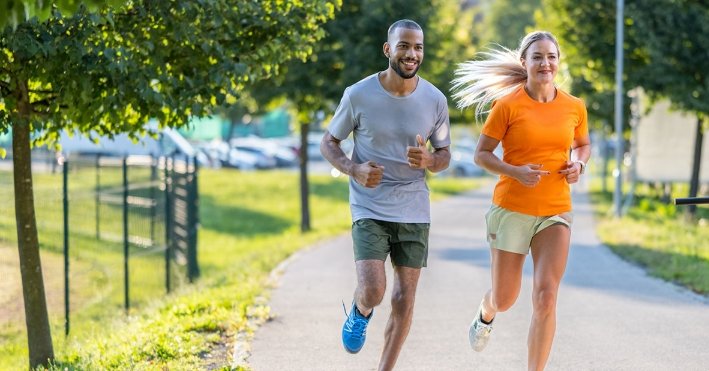
Conclusion
Breathable socks aren’t just about comfort—they’re a step toward a healthier you and a healthier planet. By choosing eco-friendly options, you support innovation in sustainable materials, with 60% of consumers now prioritizing greener products. Plus, many are willing to pay up to 30% more for these choices. This demand is driving growth in biodegradable textiles, projected to rise over 10% annually.
Tip: Small changes, like picking the right socks, can make a big difference. You’ll enhance your workouts and reduce your environmental footprint, one step at a time. 🌱
FAQ
What makes breathable socks eco-friendly?
Breathable socks become eco-friendly when made from sustainable materials like bamboo, organic cotton, or recycled fibers. These materials reduce waste, require fewer resources, and decompose faster than synthetic options. Look for certifications like GOTS or OEKO-TEX to ensure their environmental impact is minimal. 🌱
Can breathable socks really improve my workout?
Absolutely! Breathable socks keep your feet dry, prevent blisters, and enhance comfort. Some even offer compression for better blood flow and reduced fatigue. When your feet feel good, you can focus on pushing your limits during workouts.
How do I care for my breathable socks to make them last longer?
Wash them in cold water with gentle detergent. Avoid bleach and fabric softeners. Air drying is best, but if you use a dryer, stick to low heat. Washing them inside out helps preserve their moisture-wicking properties.
Are bamboo socks better than cotton for workouts?
Yes, bamboo socks are softer, more moisture-wicking, and temperature-regulating compared to cotton. They’re also eco-friendly and biodegradable. Cotton absorbs sweat but dries slowly, which can lead to discomfort during intense workouts.
How do I know if a brand is truly sustainable?
Check for eco-certifications like GOTS, OEKO-TEX, or Fair Trade. Look for transparency in their sustainability practices, such as using recycled materials or reducing carbon emissions. Brands that disclose their efforts are usually more trustworthy.
Tip: Supporting eco-conscious brands helps you stay fit while protecting the planet! 🌍
Relate
1.The 16 Best Moisture-Wicking Socks in 2024, Tested by Editors →
2.Sustainability Surge →
3.Difference between merino wool socks and wool socks: comprehensive analysis of functions, applications and environmental advantages →
4.Grip Socks: The Fitness Industry’s Best-Kept Secret for Better Stability & Performance →
5.Performance Grip Socks Market Size, Share | Forecast 2028 →
